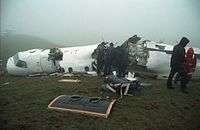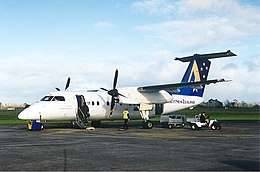Ansett New Zealand Flight 703
Ansett New Zealand Flight 703 was an Ansett New Zealand scheduled passenger transport flight from Auckland Airport to Palmerston North. On 9 June 1995, the de Havilland Canada Dash 8 aircraft flying this route crashed into hilly terrain in the Tararua Ranges, 16 km east of Palmerston North airport, during an instrument approach in bad weather. The aircraft was carrying 18 passengers and three crew members. All passengers were New Zealand citizens except for one United States citizen. The flight attendant and three passengers died as a result of the crash.
 The wreckage of the aircraft the day after the crash | |
| Accident | |
|---|---|
| Date | 9 June 1995 |
| Summary | Controlled flight into terrain |
| Site | Tararua Ranges, New Zealand |
| Aircraft type | de Havilland Canada DHC-8-102[1] |
| Operator | Ansett New Zealand |
| Registration | ZK-NEY |
| Flight origin | Auckland Airport |
| Destination | Palmerston North International Airport |
| Occupants | 21 |
| Passengers | 18 |
| Crew | 3 |
| Fatalities | 4 |
| Injuries | 17 |
| Survivors | 17 |
 |
Aircraft
.jpg)
The aircraft, registration ZK-NEY,[2] a de Havilland Canada DHC-8 Dash 8, was manufactured in Canada in 1986.
Accident
During the approach to a right turn which would place the aircraft on final approach to runway 25, the right landing gear failed to fully extend so the co-pilot began to manually extend it using a hydraulic pump. The aircraft's power settings had already been reduced to Flight Idle which was normal, but the aircraft was inadvertently allowed to descend too low toward the undulating terrain leading into Palmerston North. The initial impact with terrain occurred at 1,272 feet (388 m) above sea level; an aircraft on profile should have been 2,650 feet (810 m) above sea level.[3]
Although Flight 703's Ground Proximity Warning System (GPWS) sounded an alarm four seconds before the aircraft hit the ground, the crew was unable to avoid the accident. According to the Transport Accident Investigation Commission (TAIC) report, an audio alarm telling the crew to climb the aircraft should have sounded 17 seconds before impact, but the GPWS malfunctioned, for reasons that have never been determined. There was an investigation by the New Zealand Police in 2001[4] into whether or not a mobile phone call from the aircraft may have interfered with the system. The official crash report[3] does mention the following on page 69:
"The aircraft manufacturer's avionics representative advised that there was no likelihood that the operation of a computer, other electronic device or a cell phone would have affected the aircraft's flight instruments."
The captain's defence was that 4.5 seconds before impact the radar altimeter display flipped 1,000 feet in altitude as he watched.
Crash site
Flight 703 pancaked onto a hilltop and broke up as it slid along the ground, killing the flight attendant instantly. Passenger Reginald John Dixon tried to free two others trapped near the wing root as the wreckage caught fire. He failed to free them and a flash fire critically burned him. He died from his injuries two weeks later. Thus, three passengers also died and many others sustained injuries.

For his bravery in a dangerous situation, Dixon was awarded the New Zealand Cross, New Zealand's highest award for civilian bravery.[5]
Possible radar altimeter malfunction
Later study of the wreckage of Flight 703 revealed that the antennas for the radar altimeter (which sends a signal to the GPWS indicating how far above the ground the aircraft is) had been painted and this possibly reduced the GPWS' ability to provide a timely alarm, although later comments by TAIC insisted the paint did not block or reflect signals.[6] Radar altimeter antennas are clearly embossed with the words, "do not paint", a warning that was not heeded. Bench testing of the radar altimeter proved the unit was still functioning perfectly after its recovery from the wreckage.
See also
- Air New Zealand Flight 901
- List of accidents and incidents involving commercial aircraft
- New Zealand National Airways Corporation Flight 441
References
- Dash 8 Down: the Inside Story of Ansett Flight 703. ISBN 1-86941-489-6. Guerin, Michael; 2001; Random House; 186pp; Paperback;
- Accident description at the Aviation Safety Network
- "Active Aircraft Register (ZK-NEY)". Civil Aviation Authority of New Zealand.
- "Occurrence Report Details – Investigation 95-011". Transport Accident Investigation Commission. Archived from the original on 14 March 2012.
- "Ansett Plane Crash Cellphone Call". TV3 News. 15 June 2001.
- "Recipients of the New Zealand Cross". New Zealand Defence Force. Archived from the original on 8 August 2007. Retrieved 28 July 2007.
- "New Zealand officials examine delayed crash warning". Flightglobal. 20 August 1997.